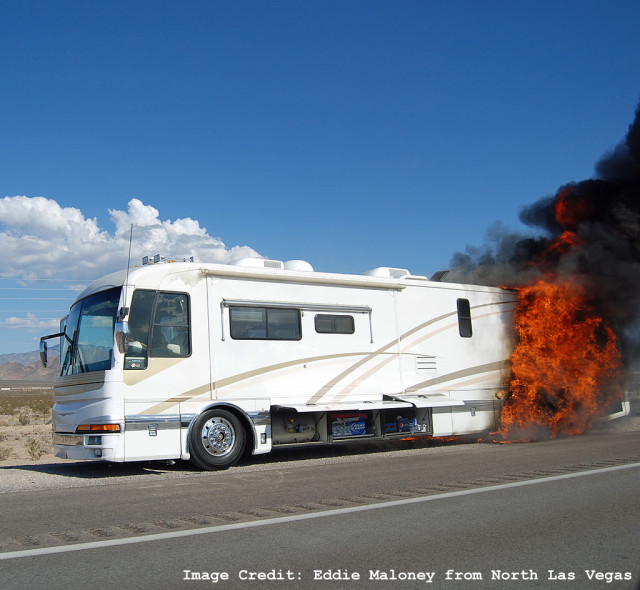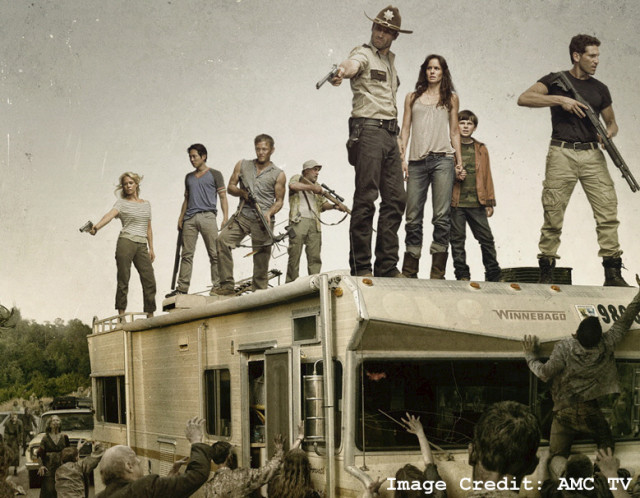This post may contain affiliate links.
Emergency preparedness is something we all need to think about, but also something we hope we never need. Well today, I’d like you to be thinking about it.
We’ve been asked by Essential Packs (you’ve probably seen them at Emergencykits.com) to help design an Emergency Preparedness Kit for RVs. And while we’re happy to help, we also realize that we’re just one couple with one situation, and our opinions are based on our reality. For example, we don’t travel with pets, or kids, or medical devices – but many of you do. What special considerations do those require in an emergency?
That’s why we’re asking for your help! We’d like to collect opinions from our readers about what you might include in an emergency kit, and why. We’ll also be discussing the kit contents with emergency preparedness experts in our community offline. At the end of the process, we should have a few sample kits to give away to those of you who helped in its design.
We all know about car emergency kits. But an RV is much different than a car. A car, for example, doesn’t typically travel with 30 gallons of fresh water. But a car is also less likely to find itself stuck in snow at an alpine lake because of a freak storm. Most people also wouldn’t take their car 30 miles into BLM desert with the intention of living out of it for a week. So, when we’re thinking about RV emergency kits, keep in mind the kinds of emergency situations you might face in your RV. Ideally, we want to be prepared for everything from the routine (a flat tire on the interstate), to the extreme (an RV ransacked by a bear in the wilderness).
To help guide the comments, I’ll post this starting list of items. The list is divided into two sections: Survival items, and Roadside Repair items. These are based off existing automotive kits, and I’m already thinking about changes I would make. And depending on how this shakes out, there might be a couple levels of kits, from basic to extreme. Here’s the list.
The RV Emergency Kit Contains These Emergency Preparedness Supplies:
- Emergency Food Bar – 2400 Calorie , (x2)
- Emergency Drinking Water Pouch – 4.22oz (x6)
- AquaTabs (20 Tablets) – Water Purification Tablets
- First Aid Kit (10 Person)
- Emergency Hand-Crank / Solar Radio with NOAA / FM / AM, LED Flashlight, USB Mobile Phone Charger
- Duracell LED Flashlight (300 Lumen) with 5 Year Duracell Batteries
- Hand Warmers (4 Pairs)
- Waterproof Matches
- Emergency Candles (x6)
- Waterproof Poncho (x2)
- Green Lightstick – 12 Hour (x3)
- Essential Packs Emergency “Coast Guard” Whistle (Loudest 2-Tone)
- N-95 Dust Mast – Flat (x2)
- Emergency Communications Planning Cards (x2)
The RV Emergency Kit Contains These Roadside Emergency Supplies:
- Jumper Cables (12′)
- Tow Rope (6,500 lb Capacity)
- Fix a Flat – Tire Repair
- Ice and Snow Window Scraper
- Window Breaker / Seatbelt Cutter Tool
- Heavy Duty Work Gloves
- Latex Gloves
- Utility Knife
- Duct Tape (50 Yards)
- Emergency Reflective Triangle
- Emergency “EMERGENCY HELP” Distress Banner for Windshield
- Blue Tarp (5′ x 7′)
So there you have it. Have a look at these lists, and see what you think, what would you add, and how do these stack up against the supplies you already travel with in your RV. Let us know in the comments. We’ll be collecting input for a couple weeks, and helpful commenters will be entered in a drawing for completed kits when we get some samples!













Solar cell phone chargers, flashlights, batteries
Looking forward to what you finally come up with for the Emergency Kit(s)!
Thought of one more, tiny little addition.
Do you know how to use the kit, particularly the first aid part?
Let’s face it – have this great all-purpose Emergency Kit with medical supplies is somewhat useless, if – when one of your companions is bleeding, unconscious, or otherwise incapacitated – you need to read the directions first.
People should consider (1) taking a first aid course (check out your local Red Cross) and (2) taking a CPR course (especially with so many retirees in RVs).
Just a thought.
You know, Stef and I got certified a couple years ago. We even wrote about it on this blog. We’re probably due again.
Excellent advice though! And highly recommended for everyone.
FYI – On “The Sweethome” (“home” site of the Wirecutter) they just posted an article Emergency Preparedness: A Guide to Supplies, Food, and Disaster Planning that may be of interest. Dealing more with natural disasters like earthquakes, but, still, lots of interesting and useful ideas.
http://thesweethome.com/reviews/emergency-preparedness/
Thanks for the link, Bob. We actually met with the head of Essential Packs at the Pomona RV show this past weekend. (He’s in the market for a Class B himself!)
Passed our list off to him (and thanks again to everyone for their input), and we’re going to have a conference call in the next week or two to iron out the list and move the project forward.
Good point! Having recently completed a Standard First Aid/CPR C course, I feel it’s a worthy investment. Also, knowing how to use an Automated External Defibrillator could be very useful in the event that one is available during a medical situation.
Oooooh! I’ve got an update on the RV kits that I’ll be posting up this week.
I think there a lot of things missing from the kits. but will only mention a couple . Based on personal experience… don’t carry matches, carry multiple Bic lighters stores wrapped in tin foil. a pair of coveralls for when you have to crawl under your vehicle or change tires,a pair of knee pads for working on your vehicle on the side of the road, a pair of clear goggles for when you are under your RV, instead of just hand held flashlights, also carry a head lamp that frees your hands up. Believe it or not carry an umbrella for one of you to hold while the other works on stuff on a rainy night. Carry two cans of that stuff that inflates your tires and repairs most punctures(that has saved my behind a few times)
Safety goggles and the fix-a-flat I think will definitely be in my recommendations. Thanks for the ideas!
How about an emergency space thermal mylar blanket? It is low-cost, lightweight, and provides protection in a variety of situations.
I thought that was already on the list, but it’s not! Thanks!
Here is one suggestion: A SteriPEN (www.steripen.com) insures plenty of potable water under difficult situations. In a nutshell, a SteriPEN uses UV light to purify liters of water in a few minutes. I own an older model, similar to the Classic 3, that has worked fine for years. I carry it on hikes, climbs, and fishing trips as backup; it weighs 3 ounces, a lot less than liters of water. It now lives in our RV.
I like the various ideas and will adopt many. I would add one item akin to duct tape. I would add some amount of Eternabond tape for a leaky roof or hose. Especially if one is camping in the boonies.
I actually travel with a small bit of Eternabond!!
For our Alaska trip, I picked up a hand held cb radio. Cell phone coverage is almost nonexistent in the north but all truckers have cb radios. If you have a problem off a main highway, there is a good chance you can reach someone by cb.
That’s a good suggestion if you’re going far afield.
I don’t know that they’ll add it to an off-the-shelf emergency kit, but it’s still a good suggestion.
I suggest they put the RV in a bag or backpack with space enough for a few personal items such as a change of clothes and a waterproof bag for copies of important papers and medicine.
Your list is very close to what I carry. I would add a reflective vest, compass, and flares, I travel with three dogs, so I would add reflective leashes which carries a cloth water bowl. Also I would add benedryl (or an epipen) and snake bite kit.
Essential Packs already has a pretty extensive selection of first aid supplies. It’s quite possible a snake bite kit might be in one of them.
This is the first time I’ve commented, although I found your site last summer and have been following since then. Enjoy both of your perspectives. Thanks!
I will be on the road F/T next summer with my 4 cats so this post is very timely for me. I plan to have one pillowcase for each kitty, with a velcro tie & identifying info attached. Carriers are great, but bulky & what happens if you need to get out NOW? Pillowcases are small enough to be stored near an exit and are light & air-permeable. (I had a house fire 6 mos ago so exit speed is in the forefront of my mind).
Thanks again for all you do!
Well we’re glad you finally decided to speak up! Welcome aboard!
I can’t imagine how stressful a house fire is. Glad you and your clan made it out safely.
There’s a neighborhood cat who has sort of lived in our yard for years. She’s actually very sweet, and part of the family by now.
But I think SHE WOULD KILL ME if I tried to put her in a pillow case! Your felines must be better trained than Crabby.
Still, a good idea… Thanks for sharing!
Emergency Roadside Kit
Yes to Alert Triangle but get the kit with 3 – comes with storage box.
Sometimes in an vehicle emergency, you lose all power, so no emergency flashers. Consider adding flares and/or red alert LEDs
http://www.amazon.com/First-Alert-Emergency-Beacon-Storage/dp/B000LQ78YY/ref=sr_1_2?ie=UTF8&qid=1442075544&sr=8-2&keywords=emergency+red+alert+leds
Bright (safety orange or similar) safety vest for night emergencies. Vests don’t take up too much room and are usually loose enough to put over your regular rain gear or winter clothing.
And if you frequently go out in the boondocks where you really are alone, you might consider one of those emergency jump starter packs.
I like the vest idea. Maybe even more than the colored poncho that was suggested elsewhere. A vest could go over a poncho, and the clear ponchos are easier and cheaper to source.
I just added a vest to my shopping cart on AMZ – an add-on item that costs only about $7. May get one for my car, too.
I post to Class B Forums, too, so have been following this thread there. Someone mentioned small solar panels, for emergency charging of phones and laptops, but they take up room, too and are the least expensive of items. I did more research on the jump start packs. Used to be they were big, heavy things, with lead-acid batteries. Now they are lithium packs, with about 200CCA constant-400CCA max, come with tips and cords to charge phones and laptops, about the size of a book, and about $100.
Good overview and reviews of them here:
http://www.carbatterychargerscentral.com/car-starter-top-7-compact-battery-jump-starters/
Top rated ones in article get 80% 5star reviews. May be worth considering for the emergency RV power supply/jump start.
I have a desk-size folding battery-operated fan that is a must for traveling!
Emergency road flares, canned air horn, and just below the utility knife you could list utility ammo – just in case.
I guess the utility ammo could go in the “Zombie Apocalypse” version. Love it!
If they are not already in a first aid kit, I would add sunscreen and Aloa Vera.
Thank you for all the great information.
Nice list, the preparedness section is close to what we have, right down to the emergency radio (our kit serves double-duty in the home and RV – since we’re on the west coast it’s good to be prepared in case of earthquake). We added emergency foil blankets and a package of firestarter sticks to our kit.
In terms of first aid, we added a couple of things for specific ailments/allergies: Gravol tablets and Reactine. Since we have a dog that likes to chase wasps and bees and sometimes gets stung in her mouth/throat, we have some 25 mg Benadryl allergy tablets. Our vet suggests a dosage of 1 mg per pound, 2-3x per day if needed.
For our roadside supplies we have what you’ve listed, but I also carry a couple of ratcheting straps, some rope (in case we need to string the tarp up), a compact 4-ton bottle jack, and a full-size fire extinguisher. Since we tow a travel trailer we have four levelling blocks anyway (to use with the bottle jack in case we need to swap out a flat tire on the trailer). Luckily these supplies all fit in the side storage compartments of our pickup truck’s bed and aren’t in the way (and are there for long trips without the trailer), but it is a weight penalty.
A couple of our favorite camping spots are down logging roads or narrow roads in heavily-treed areas and are subject to strong windstorms, so I also carry a ‘Trailblazer Take-Down Buck Saw’ in case the road is blocked by a fallen tree (like this one: http://www.myccr.com/gear/trail-blazer-take-down-buck-saw). Very lightweight and compact, but cuts through a fair-sized log quite easily. Of course, we haven’t needed it yet… but if I leave it home one time I bet we would 😉
Good stuff. Keep it coming!
I’d include safety eyewear. ( I have these in my emergency bag.) I ‘d also include a list of other things to have on hand that are easily available- i.e. a roll of toilet paper, hand sanitizer, large garbage bag (can also be used as a poncho, permanent marker, large Ziploc bags, clothespins (3-5), multi-tool/pocket knife
Nice list. I like that you have separated it into “emergency preparedness” and “roadside emergency”.
Regarding the “roadside emergency” kit, one would assume that the RV owner already has a good tool kit for his particular RV and has all the manuals.
I think your observation is spot on that there may be different levels of kits. Camping in a KOA with repair services and medical facilities within a few miles is quite different than if you are boon docking out in a BLM desert.
If you are boon docking away from civilization, you may want some of the “first responder” kits listed; they include things like sutures and splints. Many suppliers (like Adventure Medical) of marine medical kits rank them (in addition to number of people) by how far away you are from medical help, e.g. “coastal cruising”, “off-shore”, etc. They have one model ($1000) listed as “Supplies for offshore waters for up to 28 days for up to 14 people”, and include sutures, splints and dental supplies. I know sailors who have that type of kit, have used them in the middle of the Atlantic and were very glad to have carried it.